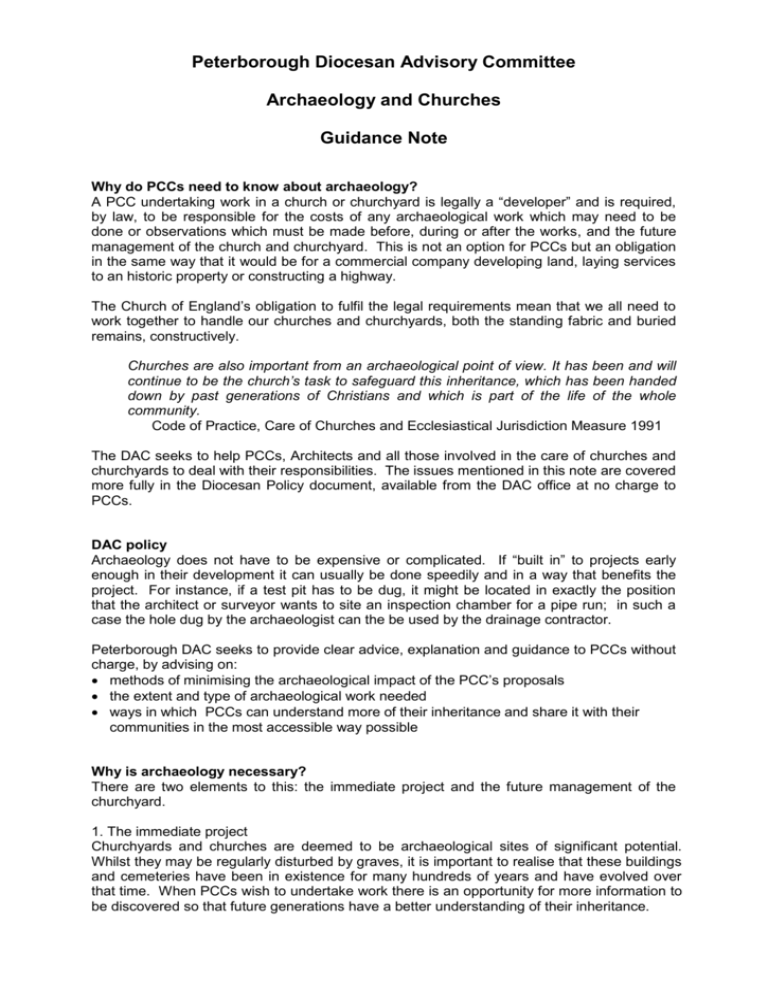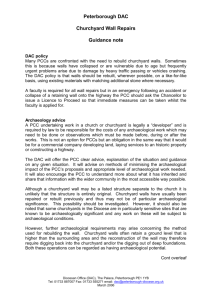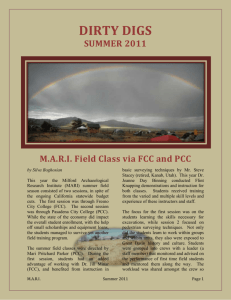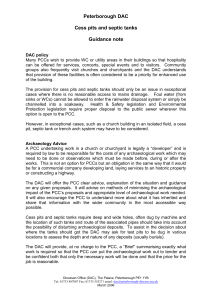Archaeology - Peterborough Diocesan Registry
advertisement

Peterborough Diocesan Advisory Committee Archaeology and Churches Guidance Note Why do PCCs need to know about archaeology? A PCC undertaking work in a church or churchyard is legally a “developer” and is required, by law, to be responsible for the costs of any archaeological work which may need to be done or observations which must be made before, during or after the works, and the future management of the church and churchyard. This is not an option for PCCs but an obligation in the same way that it would be for a commercial company developing land, laying services to an historic property or constructing a highway. The Church of England’s obligation to fulfil the legal requirements mean that we all need to work together to handle our churches and churchyards, both the standing fabric and buried remains, constructively. Churches are also important from an archaeological point of view. It has been and will continue to be the church’s task to safeguard this inheritance, which has been handed down by past generations of Christians and which is part of the life of the whole community. Code of Practice, Care of Churches and Ecclesiastical Jurisdiction Measure 1991 The DAC seeks to help PCCs, Architects and all those involved in the care of churches and churchyards to deal with their responsibilities. The issues mentioned in this note are covered more fully in the Diocesan Policy document, available from the DAC office at no charge to PCCs. DAC policy Archaeology does not have to be expensive or complicated. If “built in” to projects early enough in their development it can usually be done speedily and in a way that benefits the project. For instance, if a test pit has to be dug, it might be located in exactly the position that the architect or surveyor wants to site an inspection chamber for a pipe run; in such a case the hole dug by the archaeologist can the be used by the drainage contractor. Peterborough DAC seeks to provide clear advice, explanation and guidance to PCCs without charge, by advising on: methods of minimising the archaeological impact of the PCC’s proposals the extent and type of archaeological work needed ways in which PCCs can understand more of their inheritance and share it with their communities in the most accessible way possible Why is archaeology necessary? There are two elements to this: the immediate project and the future management of the churchyard. 1. The immediate project Churchyards and churches are deemed to be archaeological sites of significant potential. Whilst they may be regularly disturbed by graves, it is important to realise that these buildings and cemeteries have been in existence for many hundreds of years and have evolved over that time. When PCCs wish to undertake work there is an opportunity for more information to be discovered so that future generations have a better understanding of their inheritance. In most parishes we do not know if there are remains of earlier buildings such as Chantries or chapels, either attached to the current church or freestanding, or remains predating the churchyard itself. One recent piece of fieldwork in the Diocese located an Iron Age hill fort and associated deposits underneath the existing burial layer. Lack of information means PCCs have to monitor projects such as pipelines, as we have to allow for the possibility of such remains being found. 2. Future management Churches and churchyards are constantly evolving and there will undoubtedly be further works that PCCs will want to do in the future. However, next time the PCC will have access to information about the density of burials, depths of soils and deposits etc thanks to the current project. This will assist in future decision-making and may reduce the extent of archaeological work that has to be done. Archaeology is part of our stewardship. To give a couple of examples from within the Diocese: the archaeological monitoring of one project to lay a water supply ascertained that there were no burials shallower than 80cm in depth, so when a subsequent proposal came in to create a new path, that involved disturbance less than 80cm, the PCC was advised that no archaeological work needed to be done. On another site, a previous investigation had shown exactly what the density of burials was in a particular area of the churchyard, so a proposal for large scale disturbance to fit a septic tank meant that the DAC’s archaeological advisor could determine how many burials would be disturbed, thus allowing an accurate costing and assessment of the consequences for reburial. This helped the PCC to raise enough money to cover the cost of the archaeological work and to manage, in a very pastorally sensitive manner, the re-interment of those disturbed. Why do we have to provide reports on the outcome of archaeological work? The DAC will advise the PCC what to do about the written report of the archaeological work and any items that are found in the course of it. Any piece of archaeological fieldwork creates two elements that comprise the archive: finds and paperwork. Under UK law, the ownership of archaeological finds from the ground rests with the landowner (the PCC). Under Intellectual Property Rights legislation, the copyright and ownership of the paperwork rests with the person (or unit) that created it. Archaeological fieldwork archives are the final record of the site, and the aim is to ensure that this record is as accessible as possible. On the completion of the project, the archaeologist concerned deposits the archive with an appropriate public body, e.g. local museum. To make matters easier, the ownership of the objects and the licence of the copyright is transferred to the public body, otherwise it would be open to ownership challenges. For example, if the receiving body decided at a later date to undertake emergency conservation work on an object, if it did not have title to that object it could be sued for causing damage to somebody else's property. Who can do the necessary archaeology? In the majority of cases the investigation will be done by professional archaeologists at the PCC’s expense. A list of these can be website of the Institute of Field Archaeologists www.archaeologists.net or in the telephone directory. The choice of archaeologist, providing s/he meets the necessary standards, is up to the PCC but it is important that the person appointed has expertise in dealing with church work. Very occasionally it is possible to use the services of volunteers who have retired from professional work or are members of archaeological/historical societies. If the DAC considers that this is an option in particular cases the PCC will be advised accordingly, although the Diocesan Archaeological Advisor must approve the individual concerned. Diocesan Office (DAC), The Palace, Peterborough PE1 1YB Tel: 01733 887007 Fax: 01733 555271 email: dac@peterborough-diocese.org.uk April 2006 2 How does the PCC know if it will need to do archaeological work? When the PCC makes an initial approach about proposals to the DAC it will be considered by the Committee and advice will be offered about appropriate levels of response. 1. Assessing the situation The DAC’s archaeological advisor does an initial assessment. S/he may consult the Local Authorities and their archaeologists, the Sites and Monuments Records and other sources of information. Sometimes a site visit will also take place. However, this is a research phase and does not impact on the church building or churchyard in any way. The DAC is then advised: a. There are no archaeological implications or there are obvious ones for which advice can be immediately offered to the PCC b. There are, or may be, archaeological implications and evaluation must take place before advice can be offered to the PCC 2. Evaluating the situation Once the outcome of the assessment is known the need for further work is considered. In some cases this will mean test pitting in the area that will be affected by the proposed works. This will be a quick exercise and will provide the Diocesan Archaeological Advisor with a report so s/he can decide what further work, if any, is required. This work will require permission from the Chancellor, either in the form of a faculty application or a Licence to Proceed. 3. Mitigation: four ways in which the impact of proposals can be mitigated When the archaeological implications of the PCC’s proposals are clear, either at the assessment stage or after evaluation, the DAC offers advice in four ways: a. By giving specific instructions about the way the project is handled or designed to mitigate damage to vulnerable remains or structure b. By stating that the archaeological work required is monitoring so that the PCC employs an archaeologist to be present during specified parts of the main project, such as the digging of a trench. The Diocesan Archaeological Advisor will prepare a Brief describing exactly what is required so the PCC can put the job out to tender. c. By stating that archaeological remains are present and cannot be wholly preserved by modifying the PCC’s proposals. This means that recording action is needed so recording takes place either before or during the works. This recording action will have to be funded by the PCC according to a Recording Action Brief drawn up by the DAC advisor. d. By advising that excavation is necessary, usually before works on the main project commence. This usually involves a team of archaeologists undertaking a programme of intrusive work on site. The DAA will prepare a Brief for the PCC. 4. The Results The results of the archaeological work are used to benefit the future stewardship and management of the church and churchyard. This will be specified in the DAC’s advice but usually involves presentation of a full report and lodging of the report and any artefacts in an appropriate place. Copies of written material should be sent to the County Historic Environment Record, the DAC Office and the DAA. In some situations publication on particular web-sites will also be required. What about human remains? There is a presumption against disturbing human remains but in some situations it is unavoidable. There are strict Home Office regulations about this and the DAC will advise the PCC. Where works are undertaken and articulated bones (i.e. joined together as a skeleton and not scattered) are found work must stop immediately. Diocesan Office (DAC), The Palace, Peterborough PE1 1YB Tel: 01733 887007 Fax: 01733 555271 email: dac@peterborough-diocese.org.uk April 2006 3 Initial Discussion: gather archaeological information. Discuss whether there are archaeological implications with the DAC NO YES Discuss with DAA if evaluation work is required NO YES Evaluation work done to brief issued by DAA Mitigation: can works be amended to reduce archaeological impact? NO YES Archaeological Investigation required to brief issued by DAA OBTAIN NECESSARY PERMISSIONS AND PROCEED WITH WORKS NB Any archaeological work in churches or churchyards should require a Faculty Related DAC guidance notes available from the DAC office on request Church Archaeology in the Diocese of Peterborough; Guidance for Parishes, Architects and Surveyors Bell frames and bell frames Internal reordering Cess pits and septic tanks Paths Extensions and new buildings Pipe and cable runs Floor levelling, altering, covering Standing fabric intrusion Drainage and French drains WC and utility installation Heating Pipe and cable runs Diocesan Office (DAC), The Palace, Peterborough PE1 1YB Tel: 01733 887007 Fax: 01733 555271 email: dac@peterborough-diocese.org.uk April 2006 4







